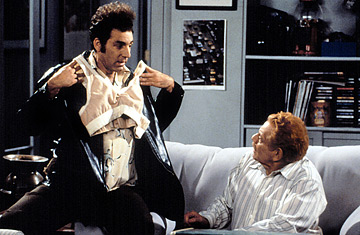
Michael Richards, as Kramer on Seinfeld, displays a "bro," or "man-ssiere," to Jerry Stiller, as Frank.
Frank Costanza wanted to call it the "man-ssiere"; Kramer insisted it had to be the "bro." Their bizarre invention, featured on one of the more ridiculous episodes of Seinfeld, was a bra for men. It played off one of the many indignities of male aging: the swelling of male breast tissue known as gynecomastia. It's almost always harmless, even in cases where it's painful — but it can be really, really embarrassing.
It also turns out to be really, really common, according to an article in the latest issue of the New England Journal of Medicine, written by Glenn Braunstein, a hormone expert at Cedars-Sinai Medical Center in Los Angeles, to familiarize other doctors with the condition. Nearly half of all men will experience it at some point in their lives, and not necessarily at the end. In fact, it's most common during adolescence; 65% of boys have it at the age of 13 or 14. Boys that age already have enough physical changes to wrestle with as it is — imagine taking a shower in gym class if you've got gynecomastia. Worse yet, imagine you're that age, with those symptoms, fearing you've got some awful disease, and being too mortified to tell your parents or your doctor about it.
If you're a teenage boy with gynecomastia, at least you probably won't have it for long. The condition is caused by — what else? — hormones that are out of whack. During mid-to-late puberty, boys' bodies may produce relatively too much estrogen, before testosterone output ramps up to adult levels. But teenagers generally get back into whack within a few years, leaving male breasts back in the nightmarish past along with acne and cracking voices.
Unfortunately, the imbalance does occasionally persist. And in older men, declining testosterone can bring it on for the first time, with no hope of it just going away. The good news is that the swelling is often so minor that it isn't even noticeable, even to the men that have it. Many cases are found by a physician first, during a routine exam. The 67-year-old described in the New England Journal article, for example, was being seen for lower back pain (if the swelling had been off-center behind the nipple, or been accompanied by discharge, Braunstein would have suspected male breast cancer, which is much rarer and not harmless at all). When gynecomastia is accompanied by pain, drugs that block estrogen, like the anticancer drug tamoxifen, can relieve it. When it's just mortifying, there's always breast-reduction surgery — or, of course, the bro.
On the other hand, says Braunstein, if it's not bothering you, don't waste time worrying about it.
